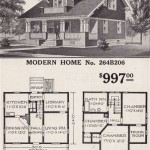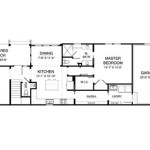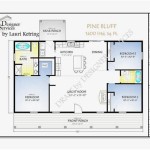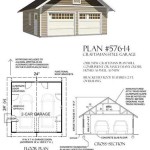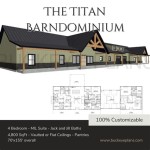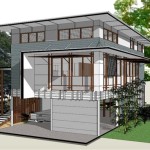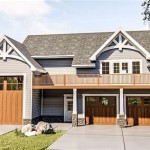```html
Rectangle Floor Plans: Optimizing Space in 3-Bedroom Homes
Rectangle floor plans are a common and efficient design choice for 3-bedroom homes. Their straightforward geometry provides ease of construction and often translates to cost-effectiveness. This article explores the advantages, considerations, and common variations found in rectangular 3-bedroom house designs, highlighting how space can be maximized within this practical layout.
The appeal of a rectangular floor plan lies in its simplicity. Walls are predominantly straight, leading to reduced material waste during construction and simplified framing processes. This simplicity doesn't necessarily equate to a lack of design flexibility. Instead, the rectangular form provides a neutral canvas upon which various architectural styles and interior layouts can be implemented. The ease of dividing the space into functional zones contributes to the overall efficiency of the design.
Key Point 1: Advantages of Rectangular Floor Plans
The benefits of choosing a rectangular floor plan for a 3-bedroom home are numerous. Cost-effectiveness is a primary advantage. Reduced construction complexity translates to lower labor expenses and minimized material usage. This budget-friendliness extends beyond the initial build, as rectangular homes often prove easier and less expensive to maintain over time. Repair work, such as roofing or siding replacements, is typically more straightforward and predictable.
Space utilization is another significant benefit. The linear nature of a rectangle lends itself well to efficient space planning. Rooms can be arranged along a central hallway, or divided into zones for living, sleeping, and utility purposes. Furniture placement is generally less challenging in rectangular rooms compared to more irregular shapes, maximizing the usable square footage. The ability to arrange rooms in a linear fashion also simplifies the flow of traffic throughout the house. Consider a rectangular house with the living, dining, and kitchen areas forming a single open space along one side, allowing for easy interaction and movement. Bedrooms are then typically located on the opposite side, providing a distinct separation between living and private areas.
Adaptability is also a crucial advantage. While the rectangular form might seem restrictive, it allows for various architectural styles to be incorporated. From modern and minimalist designs emphasizing clean lines and open spaces to more traditional styles with defined rooms and classic detailing, the rectangular shape can accommodate a wide range of aesthetic preferences. Furthermore, the layout can be easily adapted during the design phase to accommodate specific needs, such as the inclusion of a home office, a larger master suite, or an expanded kitchen. Even after construction, relatively minor modifications can often be made to interior walls without significantly impacting the structural integrity of the house.
Key Point 2: Common Layout Variations in 3-Bedroom Rectangular Homes
Within the basic rectangular framework, several layout variations are commonly found in 3-bedroom homes. One popular arrangement involves placing the master bedroom at one end of the house, offering increased privacy and separation from the other two bedrooms. These secondary bedrooms are typically located closer together, often sharing a bathroom. The living spaces, including the living room, dining area, and kitchen, can be arranged in a linear fashion along the opposite side of the house, creating an open-concept living area. This configuration maximizes natural light and promotes social interaction.
Another common layout includes placing all three bedrooms along one side of the rectangle, with the living spaces occupying the other side. This arrangement often features a central hallway connecting the bedrooms and living areas. This design can be particularly suitable for families with young children, as it keeps the bedrooms close together for easier parental monitoring. In some variations, the master bedroom might still be positioned at one end of the bedroom wing, providing a degree of separation from the other bedrooms. The kitchen can be located at either end of the living area, depending on the desired flow and functionality.
Split-bedroom layouts are also frequently utilized in rectangular 3-bedroom homes. In this design, the master bedroom is positioned on one side of the living area, while the other two bedrooms are located on the opposite side. This arrangement provides maximum privacy for the master suite and is often favored by families with older children or those who regularly host guests. The living area then serves as a buffer zone between the master bedroom and the secondary bedrooms. Hallways might be minimized in this layout, with the living spaces directly connecting the bedroom wings. This design requires careful consideration of sound insulation to minimize noise transfer between the bedrooms and living areas.
Stacking the bedrooms vertically is another option, particularly in multi-story rectangular homes. The ground floor often houses the living spaces, while the bedrooms are located on the upper level. This arrangement allows for a clear separation between living and sleeping areas and is suitable for smaller lots where maximizing vertical space is essential. Careful planning is necessary to ensure sufficient natural light and ventilation in the upper-level bedrooms. Additionally, the placement of staircases and hallways should be optimized to minimize wasted space and ensure efficient circulation throughout the house.
Key Point 3: Considerations for Maximizing Space and Functionality
While rectangular floor plans offer inherent advantages in terms of space utilization, careful planning is still essential to maximize functionality and comfort. The location of windows and doors plays a crucial role in optimizing natural light and ventilation. Large windows strategically placed along the longer sides of the rectangle can flood the interior with sunlight, reducing the need for artificial lighting during the day. Proper ventilation is equally important for maintaining air quality and preventing moisture buildup. Cross-ventilation, achieved by placing windows on opposite sides of the house, can effectively circulate air and create a comfortable indoor environment.
Storage solutions are another critical consideration in 3-bedroom homes. Maximizing closet space in each bedroom is essential for keeping clutter at bay. Built-in shelving, drawers, and organizers can further enhance storage capacity. In addition to bedroom closets, consider incorporating storage solutions in other areas of the house, such as entryways, hallways, and laundry rooms. Utility rooms and garages can also be organized with shelving, cabinets, and overhead storage systems to maximize their functionality. Thinking vertically and utilizing wall space effectively can significantly increase storage capacity without sacrificing valuable floor space.
Open-concept living spaces are frequently incorporated into rectangular floor plans to create a sense of spaciousness and facilitate social interaction. Combining the living room, dining area, and kitchen into a single open space allows for a seamless flow between these areas. However, careful planning is needed to define distinct zones within the open space. Furniture arrangement, area rugs, and changes in floor covering can be used to visually separate the different functions. A kitchen island or peninsula can serve as a natural divider between the kitchen and the dining area. Lighting can also be used to define specific zones, with brighter lighting in the kitchen and softer lighting in the living area.
The incorporation of outdoor living spaces can further enhance the functionality and appeal of a rectangular 3-bedroom home. A patio or deck extending from the living area can provide additional space for relaxation, entertaining, and outdoor dining. Strategically positioned landscaping can create privacy and enhance the aesthetic appeal of the outdoor space. A covered porch or veranda can provide protection from the elements and extend the usability of the outdoor space throughout the year. Careful consideration should be given to the orientation of the outdoor living space to maximize sunlight and minimize exposure to harsh weather conditions.
Ultimately, the success of a rectangular 3-bedroom floor plan depends on careful planning and attention to detail. By considering the advantages of this design, exploring common layout variations, and focusing on maximizing space and functionality, homeowners can create a comfortable, efficient, and aesthetically pleasing living environment.
```
Rectangle House Plan With 3 Bedrooms No Hallway To Maximize Space Plans Small

17 Best Of 3 Bedroom Rectangular House Plans Robobrawl Com Two Story Rectangle Floor

3 Bed House Plans And Home Designs Wide Bay Homes Hervey

Small House Plans Beautiful Houses S Floor Plan One Story

30x50 Rectangle House Plans Expansive One Story Ranch Style

House Plans Home And Floor From Ultimate

3 Bedroom House Plan With Great Front View

Independent Square 3 Bedroom Floor Plan

Ranch House Plan With 3 Bedrooms And 2 5 Baths 1219
House Plan Of The Week Super Simple Barndominium Builder

